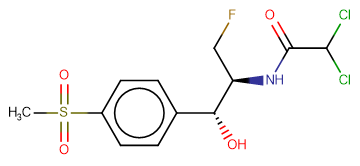
Florfenicol
CAS No. 73231-34-2
Florfenicol( SCH 25298 )
Catalog No. M15800 CAS No. 73231-34-2
Florfenicol is a fluorinated synthetic analog of thiamphenicol.
Purity : >98% (HPLC)
 COA
COA
 Datasheet
Datasheet
 HNMR
HNMR
 HPLC
HPLC
 MSDS
MSDS
 Handing Instructions
Handing Instructions
| Size | Price / USD | Stock | Quantity |
| 100MG | 43 | In Stock |


|
| 500MG | 73 | In Stock |


|
| 1G | Get Quote | In Stock |


|
Biological Information
-
Product NameFlorfenicol
-
NoteResearch use only, not for human use.
-
Brief DescriptionFlorfenicol is a fluorinated synthetic analog of thiamphenicol.
-
DescriptionFlorfenicol is a fluorinated synthetic analog of thiamphenicol. In the United States, florfenicol is currently indicated for the treatment of bovine respiratory disease (BRD) associated with Mannheimia (Pasteurella) haemolytica, Pasteurella multocida, and Haemophilus somnus, for treatment of bovine interdigital phlegmon (foot rot, acute interdigital necrobacillosis, infectious pododermatitis) associated with Fusobacterium necrophorum and Bacteroides melaninogenicus. Florfenicol is also used in aquaculture, and is licensed for use in the United States for the control of enteric septicemia in catfish.
-
In Vitro——
-
In Vivo——
-
SynonymsSCH 25298
-
PathwayOthers
-
TargetOther Targets
-
RecptorOthers
-
Research AreaInfection
-
Indication——
Chemical Information
-
CAS Number73231-34-2
-
Formula Weight358.21
-
Molecular FormulaC12H14Cl2FNO4S
-
Purity>98% (HPLC)
-
SolubilityDMSO: 10 mM
-
SMILESCS(=O)(=O)c1ccc(cc1)[C@H]([C@@H](CF)NC(=O)C(Cl)Cl)O
-
Chemical NameAcetamide, 2,2-dichloro-N-((1S,2R)-1-(fluoromethyl)-2-hydroxy-2-(4-(methylsulfonyl)phenyl)ethyl)-
Shipping & Storage Information
-
Storage(-20℃)
-
ShippingWith Ice Pack
-
Stability≥ 2 years
Reference
1. Thiry J, et al. Vet Rec. 2014 Apr 26; 174(17):430.
molnova catalog



related products
-
4-(Dimethylamino)cin...
4-(Dimethylamino)cinnamic acid (DMACA) could be as charge transfer (ICT) probe.
-
Rebaudioside A
Rebaudioside A is a novel agent of glycoside clathration of pharmacons, acts as α-glucosidase inhibitor.
-
Isolappaol A
Isolappaol A is a natural product for research related to life sciences.



 Cart
Cart
 sales@molnova.com
sales@molnova.com


